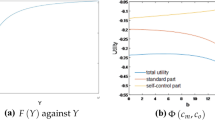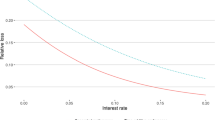Abstract
Unfunded public pension systems are primarily justified on grounds that many individuals lack sufficient capacity to appropriately save for retirement. We begin with a review of the known principle that a standard life-cycle/permanent-income consumer who discounts the future at an exponential rate can benefit from an unfunded public pension system only if the internal rate of return exceeds the private rate of return. However, a pay-as-you-go program with a below market internal rate can in fact improve lifetime utility if the consumer misestimates social security benefits, uses a hyperbolic discount function rather than the exponential function, uses a short planning horizon, behaves impulsively, or if a fraction of the population do no saving at all. A literature has consequently arisen to study how severe these behavioral defects need to be in order to justify a pay-as-you-go program. We survey this literature, and we conclude that the results are highly mixed as to whether an unfunded public pension that earns a below-market internal rate of return can be justified on grounds of shortsightedness in model economies. The challenge for this literature is that the conclusions crucially depend on the particular values of the preference parameters that are used in the simulation experiments, and these preference parameters are not observable, nor is there much consensus concerning the values that should be used in simulations. In fact, even when the analysis is confined to a small and reasonable space of the unobservable preference parameters, it is possible to reach nearly any policy conclusion. We offer some guidance for future work in this area.
Similar content being viewed by others
Notes
Throughout this paper we refer to the terms public pension, social security, and social insurance, to equivalently denote a government-managed retirement support program with compulsory participation.
It should be noted that in addition to a myopia justification (as represented by the character of Jack), Musgrave (1968) also characterizes the possibility of a moral hazard basis for social security in the form of a prudent, yet potentially free-riding, Homer. Musgrave states, “the very guarantee that minimum income payments will be received when needed gives an incentive (under the budgetary system) not to provide for old age and not to insure. Even Homer, though potentially prudent, will try to maximize his consumption over time by creating situations of need” (p.27). Such a moral hazard justification for social security is beyond the scope of this survey, but see Kotlikoff (1987, 1989) and Homburg (2000) for more on this idea. Also, see Blinder (1988) and Boadway and Cuff (2005) for a survey of other possible justifications for social security in addition to that of shortsighted behavior.
This setup for b(t) implies a balanced social security budget. The U.S. system has been collecting surpluses of tax revenues at least since 1983 (Smetters 2004). These surpluses have been lent to the U.S. Treasury at interest (the total sum of which has been labeled the “Social Security Trust Fund”). There is an ongoing debate about whether the Trust Fund can be considered a real asset. For more on this discussion see Elmendorf and Liebman (2000), Smetters (2003, 2004), Diamond and Orszag (2004, 2005), and Diamond (2006).
Feldstein (1985) employs a two-period OLG model and shows that the internal rate of return on unfunded social security equals the rate of real wage growth plus the rate of population growth plus the product of the two rates. The internal rate of return in Eq. 7 cannot be solved explicitly as in the two-period model, but numerical calculations easily show that the internal rate of return is positively related to the rate of real wage growth and to the ratio of workers to retirees (which is positively related to the rate of population growth), and so the setting that we use is qualitatively consistent with Feldstein’s model.
See Huang and Caliendo (2007) for a survey of empirical estimates.
See Laibson (1997) and the references therein.
Recall that in Feldstein’s paper the individual discounts the future in making decisions, but “true” utility is the non-discounted sum of period utility.
For example, the Health and Retirement Study and the Survey of Consumer Finances indicate that nearly 90% of Americans have planning horizons that are at least this short.
References
Aaron HJ (1999) Retirement, retirement research, and retirement policy. In: Aaron HJ (ed) Behavioral dimensions of retirement economics. Brookings Institution Press and Russell Sage Foundation, Washington, DC, pp 43–80
Akerlof GA (1998) Comment. Brookings Pap Econ Act 1:185–189
Akerlof GA (2002) Behavioral macroeconomics and macroeconomic behavior. Am Econ Rev 92(3):411–433
Ando A, Modigliani F (1963) The ‘life cycle’ hypothesis of saving: aggregate implications and tests. Am Econ Rev 53(1):55–84
Bernheim BD, Skinner J, Weinberg S (2001) What accounts for the variation in retirement wealth among U.S. households? Am Econ Rev 91(4):832–857
Blinder AS (1988) Why is the government in the pension business? In: Wachter SM (ed) Social security and private pensions: providing for retirement in the twenty-first century. Lexington Books, Lexington, pp 17–34
Boadway R, Cuff K (2005) Evaluating public pensions. In: Shah A (ed) Public expenditure analysis. The World Bank, Washington, DC, pp 69–133
Bullard J, Feigenbaum J (2007) A leisurely reading of the life-cycle consumption data. J Monet Econ 54(8):2305–2320
Caliendo F, Aadland D (2007) Short-term planning and the life-cycle consumption puzzle. J Econ Dyn Control 31(4):1392–1415
Caliendo FN, Gahramanov E (2007) Hunting the unobservables for optimal social security: a general equilibrium approach. Working paper, Department of Economics, Utah State University, Logan, UT
Campbell JY (2001) Forecasting U.S. Equity returns in the 21st century. In: Estimating the real rate of return on stocks over the long term. Social Security Advisory Board, Washington, DC, pp 3-10
Choi JJ, Laibson D, Madrian BC, Metrick A (2006) Saving for retirement on the path of least resistance. In: McCaffery EJ, Slemrod J (eds) Behavioral public finance. Russell Sage, New York, pp 304–352
Deaton A (1992) Understanding consumption. Oxford University Press, New York
Diamond P (2006) Social security, the government budget, and national savings. In: Szenberg M (ed) Samuelsonian economics in the 21st century. Oxford University Press, New York, pp 54–65
Diamond P, Orszag P (2004) Saving social security: a balanced approach. Brookings, Washington DC
Diamond P, Orszag P (2005) Saving social security. J Econ Perspect 19(2):11–32
Docquier F (2002) On the optimality of public pensions in an economy with life-cyclers and myopes. J Econ Behav Organ 47(1):121–140
Elmendorf D, Liebman J (2000) Social security reform and national saving in an era of budget surpluses. Brookings Pap Econ Act 2000(2):1–71
Feigenbaum J (2008a) Can mortality risk explain the consumption hump? J Macroecon (in press)
Feigenbaum J (2008b) Precautionary saving unfettered. Working paper, Department of Economics, University of Pittsburgh, Pittsburgh, PA
Feldstein M (1985) The optimal level of social security benefits. Q J Econ 100(2):303–320
Findley TS (2007) Impulsive consumers and optimal social security. Working paper, Department of Economics, Illinois State University, Normal, IL
Findley TS, Caliendo F (2007) Short horizons, time inconsistency, and optimal social security. Working paper, Department of Economics, Illinois State University, Normal, IL
Friedman M (1957) A theory of the consumption function. Princeton University Press, Princeton
Friedman MA (1963) Windfalls, the ‘horizon,’ and related concepts in the permanent income hypothesis. In: Christ C et al (eds) Measurement in economics. Stanford University Press, Stanford, pp 1–28
Goss SC (2005/2006) The financial outlook for the social security disability insurance program. Soc Secur Bull 66(3):47–52
Gourinchas P-O, Parker JA (2002) Consumption over the life cycle. Econometrica 70(1):47–89
Hansen LP, Heckman JJ (1996) The empirical foundation of calibration. J Econ Perspect 10(1):87–104
Homburg S (2000) Compulsory savings in the welfare state. J Public Econ 77(2):233–239
Huang KXD, Caliendo FN (2007) Rationalizing seven consumption-saving puzzles in a unified framework. Working paper, Department of Economics, Vanderbilt University, Nashville, TN
İmrohoroğlu A, İmrohoroğlu S, Joines DH (2003) Time-inconsistent preferences and social security. Q J Econ 118(2):745–784
Kotlikoff LJ (1979) Testing the theory of social security and life cycle accumulation. Am Econ Rev 69(3):396–410
Kotlikoff LJ (1987) Justifying public provision of social security. J Policy Anal Manage 6(4):674–689
Kotlikoff LJ (1989) On the contribution of economics to the evaluation and formation of social insurance policy. Am Econ Rev 79(2):184–190
Kotlikoff LJ, Spivak A, Summers LH (1982) The adequacy of savings. Am Econ Rev 72(5):1056–1069
Laibson D (1997) Golden eggs and hyperbolic discounting. Q J Econ 62:443–477
Laibson D (2003) Intertemporal decision making. Encyclopedia of cognitive science. Nature, London
Munnell AH (1977) The future of social security. Brookings, Washington, DC
Musgrave RA (1968) The role of social insurance in an overall program for social welfare. In: Bowen WG, Harbison FH, Lester RA, Somers HM (eds) The princeton symposium on the american system of social insurance. McGraw-Hill, New York, pp 23–40
Musgrave RA, Musgrave PB (1984) Public finance in theory and practice, 4th edn. McGraw-Hill, New York
Smetters K (2003) Is the social security trust fund worth anything? Working paper no. 9845, National Bureau of Economic Research Working Paper Series
Smetters K (2004) Is the Social Security Trust Fund a store of value? Am Econ Rev 94(2):176–181
Speight AEH (1989) Consumption, rational expectations and liquidity. St. Martin’s, New York
Thaler RH, Benartzi S (2004) Save More TomorrowTM: using behavioral economics to increase employee saving. J Polit Econ 112(1):164–187
Acknowledgement
We thank Jim Payne for comments and suggestions.
Author information
Authors and Affiliations
Corresponding author
Rights and permissions
About this article
Cite this article
Findley, T.S., Caliendo, F.N. The behavioral justification for public pensions: a survey. J Econ Finance 32, 409–425 (2008). https://doi.org/10.1007/s12197-008-9036-4
Published:
Issue Date:
DOI: https://doi.org/10.1007/s12197-008-9036-4




